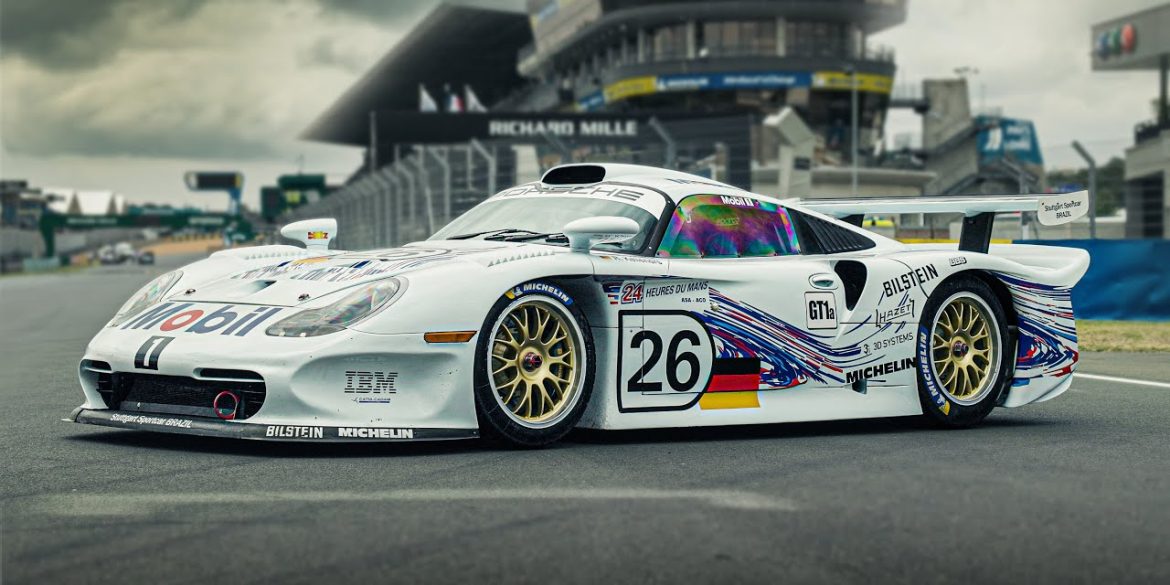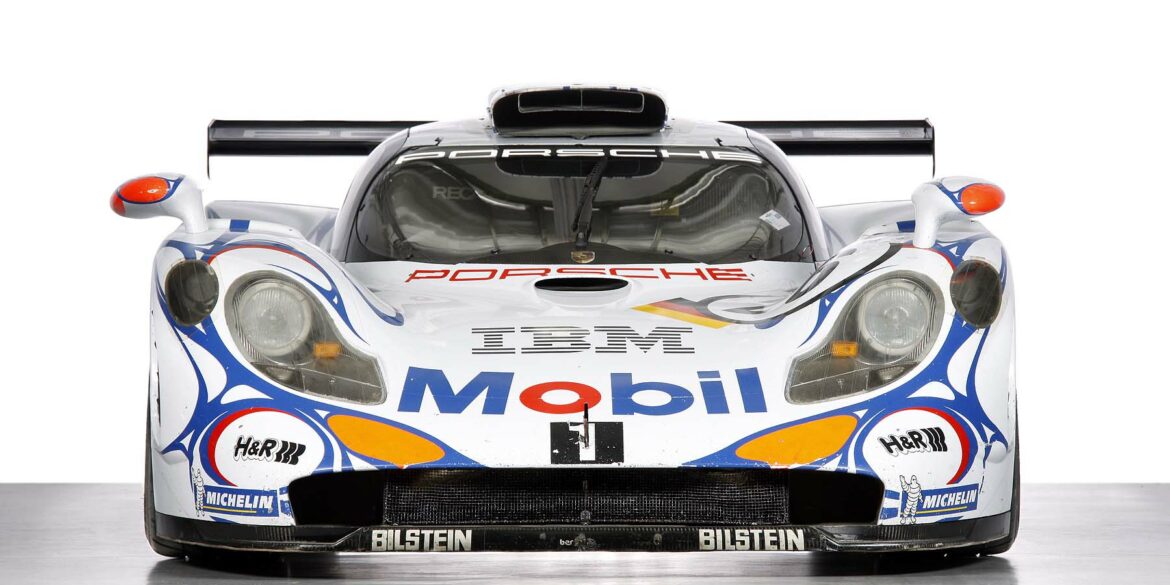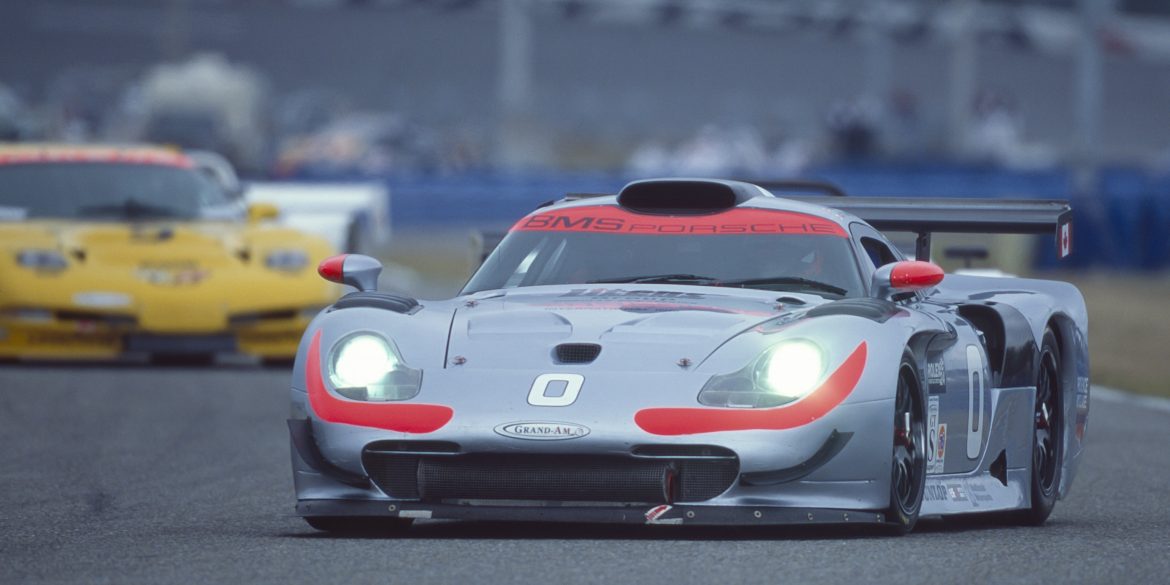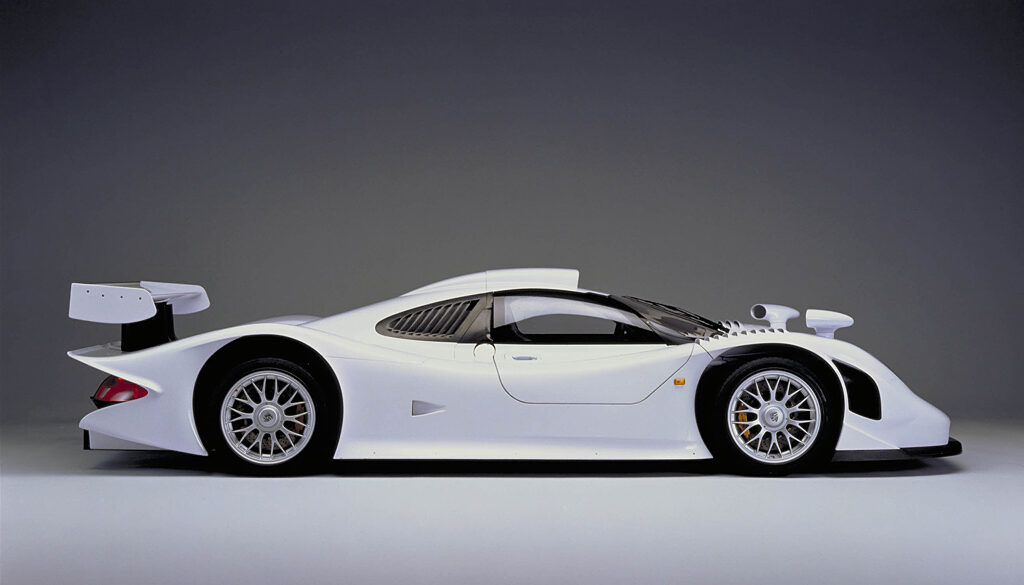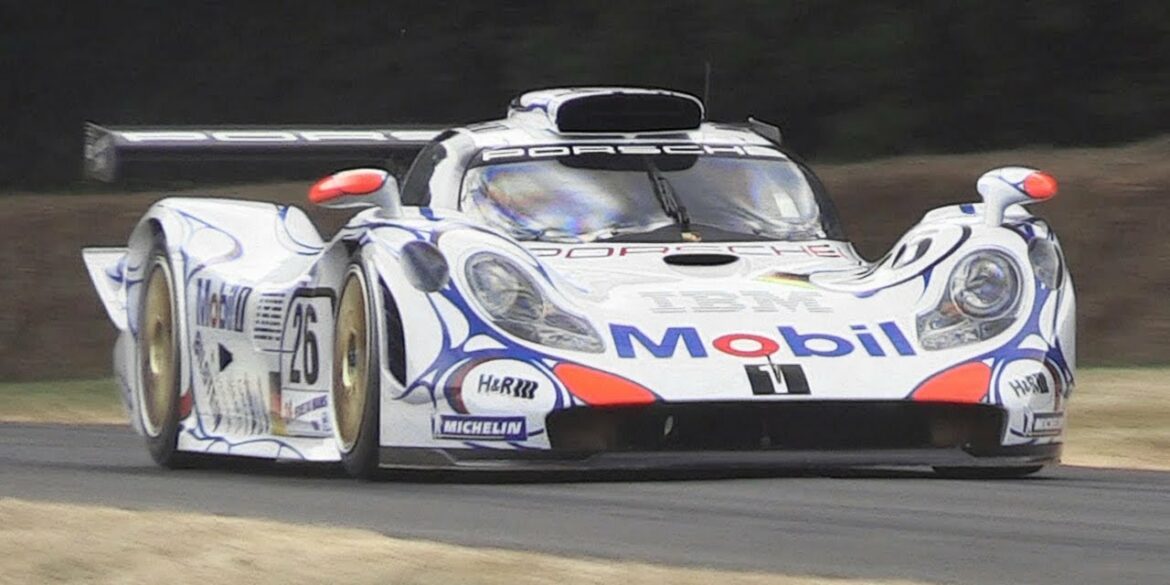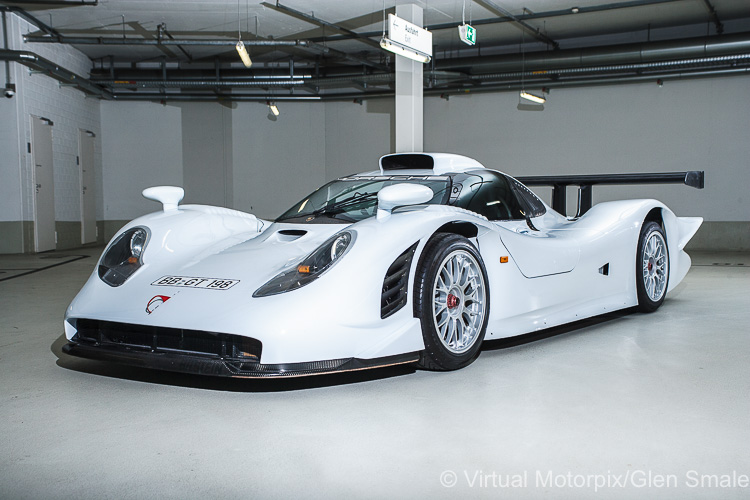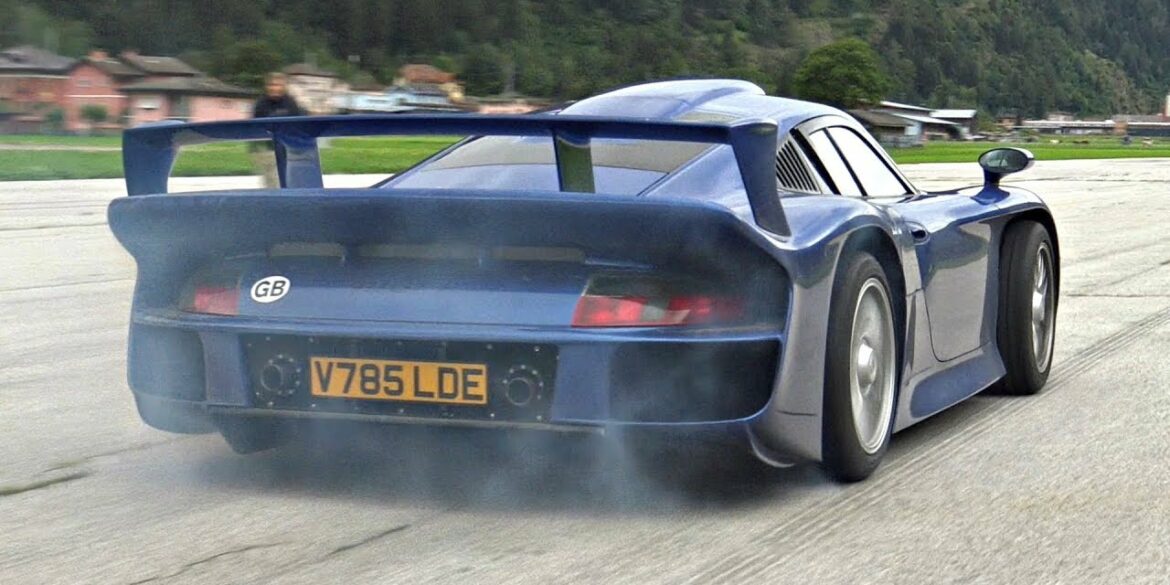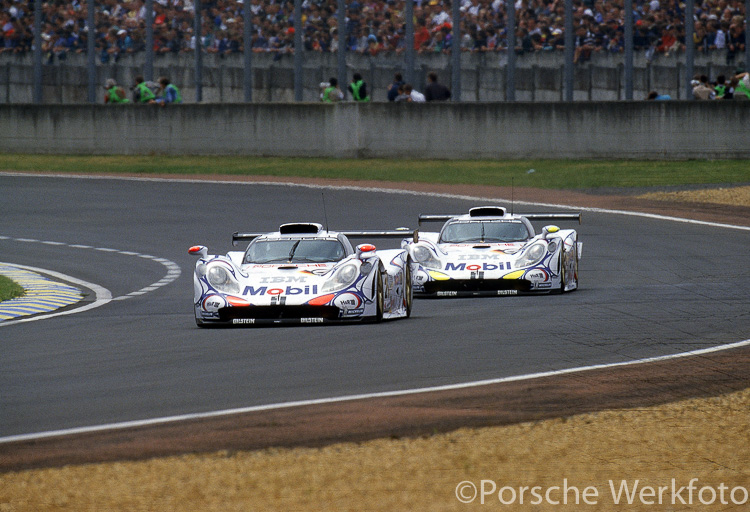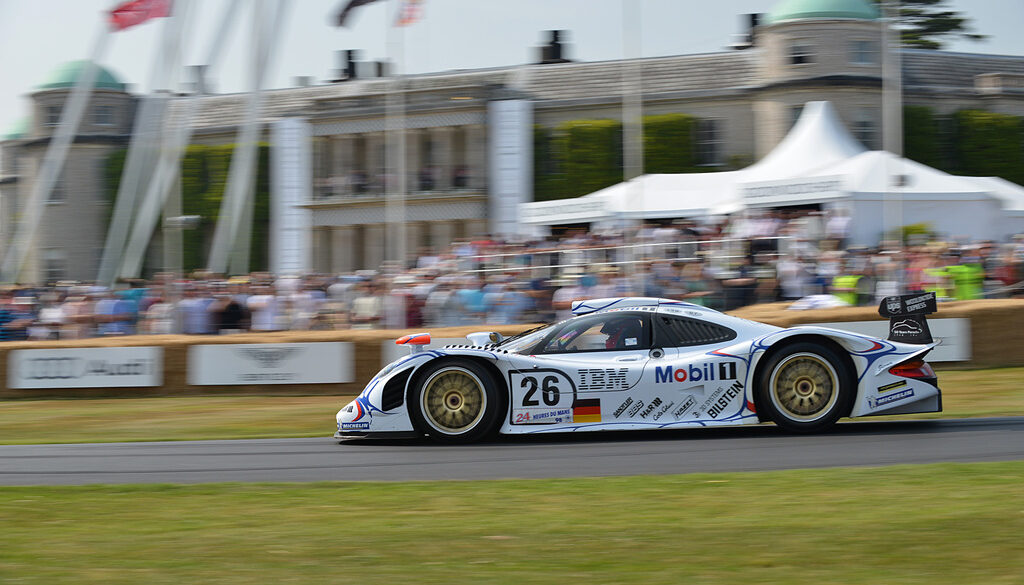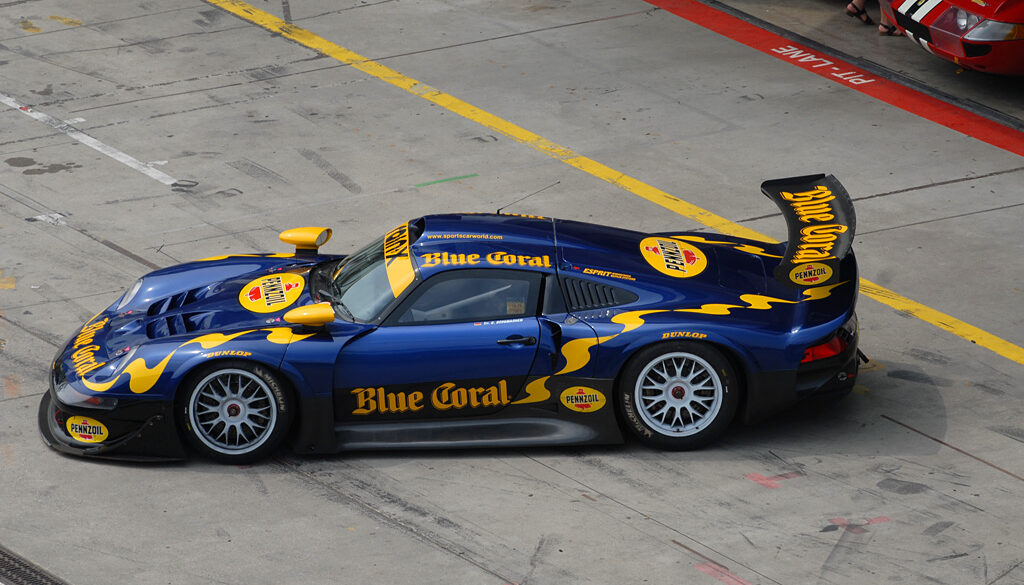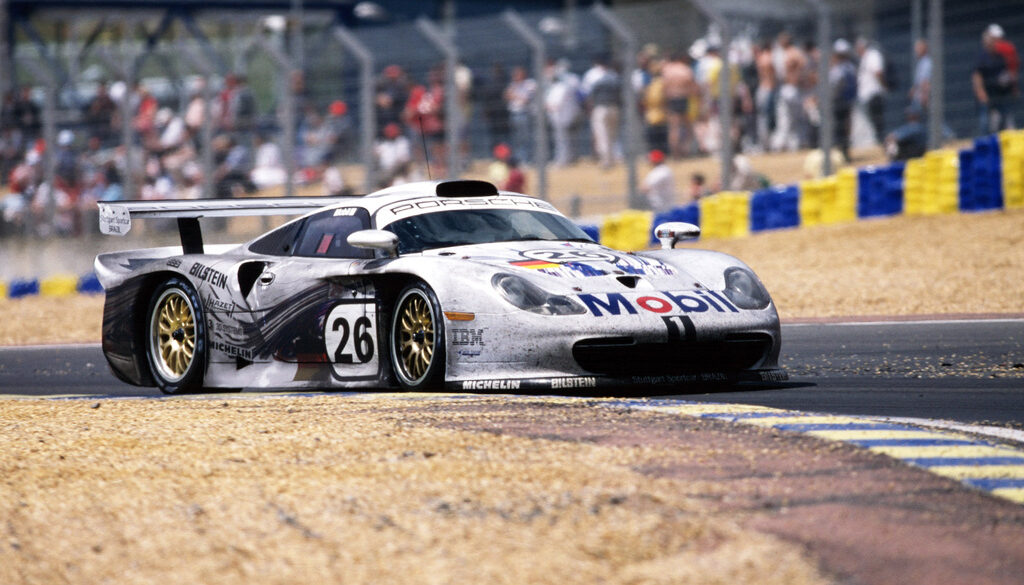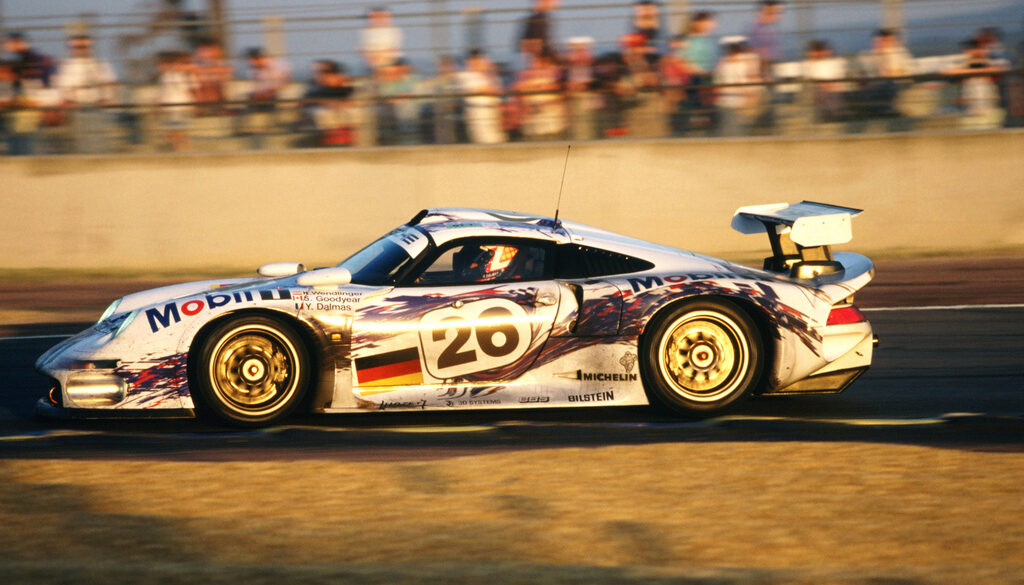In spite of its 911 moniker, the Porsche 911 GT1 actually had very little in common with the 911 of the time, only sharing the front and rear headlamps with the production sports car. Designed and developed to compete in the GT1 class of sportscar racing, which also required a...
Spying the Le Mans-winning Porsche 911 GT1 against a wintery Colorado mountainside, veteran Porsche racer Stéphane Ortelli could be forgiven for thinking he was dreaming. It’s a far cry from the Circuit de La Sarthe on that sweltering June afternoon in 1998, when Ortelli and teammates Laurent Aïello and Allan...
The Porsche 911 GT1 Evo is considered one of the standout racing cars from the 1990s. This example, chassis 117 is notably one of the more successful ones with a remarkable race history. Take a look at this video to explore the fascinating story behind this legendary racing car and experience...
In spite of its 911 moniker, the car actually had very little in common with the 911 of the time, only sharing the front and rear headlamps with the production sports car. Designed and developed to compete in the GT1 class of sportscar racing, which also required a street-legal version...
To compete in GT1 racing, Porsche produced a small batch of road-legal cars, resulting in the exclusive 993-based Porsche 911 GT1 Strassenversion. Alongside the likes of Mercedes-Benz CLK GTR and Maserati MC12, it utilized the 993’s chassis and front end, combined with the rear design of the iconic 962 race...
With Stuttgart neighbor Mercedes on the rampage, Porsche had trouble on the track in the late 1990s GT1 era. But when it was essential to pull out a win at Le Mans to celebrate Porsche’s 50 years of making cars, the GT1/98 had what it took. Planning for Le Mans...
After a promising season in 1996, Porsche updated their GT1 contender to Evolution specification. This included redesign bodywork, a new front suspension and a six-speed sequential transmission half way through the season. The sport’s governing body, the FIA, had taken an interest in the action-packed series and for 1997 the...
The EVO was the updated version of the 911 GT1 and featured an aerodynamically advanced body. Here’s a special video from the folks at Supercar Driver where they got to film 1 of only 9 911 GT1 EVOs in the world that been converted for road use....
1998 24 Hours of Le Mans winner, the Porsche 911 GT1-98 with chassis number 003, in action at the 2018 Goodwood Festival of Speed. ...
1997 Porsche 911 GT1 Straßenversion Porsche developed two prototype cars, both fully road-legal versions that were GT1 Straßenversion cars. The first was delivered in early 1996 to the German Federal Ministry of Transport, Building, and Urban Development for compliance testing, which it passed. The second prototype vehicle is in the...
Aimed at winning Le Mans and complying to European road regulations, the sole 911 GT1 ’98 Straßenversion is a unique singularity in Porsche history. It has all the great hallmarks of successful race car design in an uncompromising road car package. It’s also a good example of the difference between...
In this very special video, the crew from Supercardriver join Tom Hartley Jnr as he talks them through the latest unicorn on offer; the Porsche 911 GT1 EVO. As 1 of only 9 in the world, this incredibly rare car has been converted beautifully for road use – but how...
No Subscription? You’re missing out Get immediate ad-free access to all our premium content. Get Started Already a Member? Sign in to your account here....
No Subscription? You’re missing out Get immediate ad-free access to all our premium content. Get Started Already a Member? Sign in to your account here....
No Subscription? You’re missing out Get immediate ad-free access to all our premium content. Get Started Already a Member? Sign in to your account here....
1998 Porsche 911 GT1 ’98 Technical Specifications GT1/98 race car specifications – chassis #003 Engine 6-cylinder boxer, water-cooled, aluminium engine block and cylinder heads, 2 intake and 2 discharge valves per cylinder, 2 exhaust gas turbo chargers with air restrictors, 2 charce air intercoolers, dry sump lubrication, electronic engine management...
No Subscription? You’re missing out Get immediate ad-free access to all our premium content. Get Started Already a Member? Sign in to your account here....
No Subscription? You’re missing out Get immediate ad-free access to all our premium content. Get Started Already a Member? Sign in to your account here....
Porsche 911 GT1 Review The McLaren F1, the Porsche 911 GT1 and the Mercedes CLK GTR are three of the most iconic supercars of all time. We gathered all three for one of the most exciting group tests we have ever done. Henry Catchpole drives each of these epic road...
Porsche 911 GT1 – All The Details Join James Cottingham for a user’s guide to the Porsche 911 GT1. Tons of little details make this nerd heaven. I love it....
Porsche GT1 versus McLaren F1 GTR Great battle between the Porsche GT1 and the McLaren F1 GTR at Le Mans in 1996. Listen to the great sound of the McLaren en see the nice flames at the back site of the Porsche when the driver is changing gears...
This large poster announced the 50th anniversary of the first victory by the Porsche 917 at the 1970 Le Mans 24 Hour race It all started back in early March of 2020. I had a trip planned to visit the Porsche Museum in Stuttgart, to conduct another extensive photo shoot...
Tiff Reviews the Porsche 911 GT1 Tiff Needell gets behind the wheel of the Porsche 911 GT1 – a road going race car, that has earned the title of “automotive unicorn” since its conception in the mid 1990s. The 1980s saw what many regard as the greatest decade of World Sportscar...
The 1970 #23 Porsche 917 KH at the Le Mans 50 years victory celebration at the Museum on 13/14 June 2020 More than 4.75 million visitors have passed through the doors of Porsche’s Museum in Stuttgart since the company officially opened its doors to the public on 31 January 2009....
There’s no doubt about it: the 911 GT1 EVO is still one of the best looking Porsches ever made and one of the least understood cars from Porsche. This video features not only the famous ‘Playstation’ model, but also the Straßenversion and the actual car that won the 24h of...
The Complete Book of Porsche 911 – Every Model Since 1964 by Randy Leffingwell: © Quarto Publishing The name, Randy Leffingwell, will be familiar to most Porsche enthusiasts. Leffingwell worked in Kansas City, Chicago and for the LA Times as a photographer and writer for more than two decades. In...
Rennsport Collective, Donington Hall, 20 July 2019: Porsche 996 GT1 Evo 1997 on display with numerous other Porsche classics They were all there, from a Pre-A 356 to the latest 991.2 GT3 Clubsport, by way of the most mouth-watering collection of 911s, 956 and 962s, including the indomitable 917. The...
Le Mans 24 Hour, 13-14 June 2015: Lined up prior to the formation lap are (from L-R) – the #18 Porsche 919 Hybrid driven by Marc Lieb/Romain Dumas/Neel Jani (finished 5th); #17 Porsche 919 Hybrid driven by Timo Bernhard/Brendon Hartley/Mark Webber (finished 2nd); #19 Porsche 919 Hybrid driven by Earl...
Norbert Singer, 24 Hours of Le Mans, 1996 Norbert Singer must rank as one of the most successful race engineers in Porsche’s long and glittering motorsport history. Porsche Road & Race spoke to him about his four-decade career with Porsche, the race cars he helped develop and the 24 Hours...
Porsche – The Golden Years: Leonardo Acerbi © Virtual Motorpix/Glen Smale It is always a pleasure when a top-quality book lands on my desk, so when Porsche – The Golden Years arrived at the Porsche Road & Race offices, I was especially pleased. We had the pleasure of reviewing Ferrari...
Goodwood Festival of Speed, 12–15 July 2018: Porsche GT1/98 (chassis #WP0ZZZ9RZXS100003) driven by Allan McNish/Stéphane Ortelli/Laurent Aiello to victory in the 1998 Le Mans 24-Hours, waits in the holding paddock before the run up the hill Without any doubt, one of the highlights of my year in motorsport in 2018...
This angle shows the sweeping lines of the 911 GT1/98 Strassenversion The origins of the 1998 Porsche 911 GT1 Le Mans winner can be traced back to a roadgoing version of the Group C 962 launched five years earlier. In order to homologate the 911 GT1/98, the FIA required a...
Rare Porsche 911 GT1 Racing I filmed the ultra rare 1997 Porsche 911 GT1 Straßenversion (street-legal) being unleashed on an airstrip during the Supercar Owners Circle 2018 at Ambri airport, Switzerland. Only 25 where made world wide! It has a 536bhp 3.2 liter, water-cooled twin turbo flat-six engine. Video shows...
Porsche 911 GT1 At The Goodwood Festival of Speed The first Porsche 911 GT1, developed from a 911 (993) car, did its debut in 1996 and it was able to achieve a Le Mans class win plus a few other successes. In 1997 Porsche made revisions to its GT1 racer...
Dubai 24 Hours, 11/13 January 2018: The #12 Manthey Racing Porsche 911 GT3 R driven by Lars Kern, Sven Müller, Otto Klohs and Mathieu Jaminet finished second in the A6-PRO class Our contributor in France, Lucian Sonea, recently conducted an interview with Mathieu Jaminet, one of Porsche’s Young Professional Drivers....
A single car - the 911 GT1-98 Straßenversion - was built in 1998 to homologate the all-new racing version under the new FIA regulations. The engine had to be slightly de-tuned to meet European emissions laws, although its 400 kW (544 PS; 536 hp) at 7,200 rpm and 600 N⋅m (443 lb⋅ft) of torque at 4,250 rpm proved to be more than adequate; the car could accelerate to 100 km/h (62 mph) from a standstill in 3.6 seconds on its way to a top speed of 193 mph.
Le Mans 24 Hour, 6/7 June 1998: Allan McNish, Stephane Ortelli and Laurent Aiello took the works #26 Porsche 911 GT1 to victory in the 1998 Le Mans 24 Hours This year, 2018, Porsche will celebrate its 70th anniversary. Although the official date for the registration of the first car, 356-001,...
Homologated roadgoing version of the ’97 911 GT1 Evolution racer costing $890,805 upon release. Twin-turbochargers were fitted to the M96/80 engine, which had water-cooled cylinder heads. Apparent from the front and rear lights, the GT1 shares many components with its series production counterparts, but puts them together in a more competitive way. Gone is the rear engine layout which isn't suitable for prototype GT racing, the GT1's turbocharged flat-six engine sits in front of the rear axle and is supported by chassis tubes instead of the typical 911 rear sub frame.
To comply with homologation requirements, Porsche built two street versions of their 1996 Le Mans contender. These pre-production cars are essentially the same as the race version without all the safety equipment, a higher ride height and more interior amenities. The two street versions were actually built in 1995 as 1996 model year cars. The engines were slightly detuned from 600 bhp to 544 and the gear ratios were changed.
Porsche 911 GT1 – Inside Evo Henry Catchpole recently drove the road-going Porsche 911 GT1 straßenversion at the Porsche Experience Centre at Silverstone. Here’s the background story, and some on-board footage of the drive. Porsche 911 GT1....
1998 Porsche 911 GT1 ’98 Straßenversion Pictures & Gallery...
1998 Porsche 911 GT1-98 Pictures & Gallery...
1997 Porsche 911 GT1 Straßenversion Pictures & Gallery...
1997 Porsche 911 GT1 Evolution Pictures & Gallery ...
1996 Porsche 911 GT1 Pictures & Gallery...
The 1998 GT1 car was a totally rethink and vast upgrade versus the prior year car. 1998 Le Mans 24-hour race In the 1998 jubilee year, the Porsche team celebrated its 16th overall victory in Le Mans with a double win for the 911 GT1 98. On 6th/7th June, the winning car was driven by Laurent Aiello, Allan McNish and Stéphane Ortelli. It was almost 50 years to the day on which the first Porsche sports car saw the light of day.
Towards the end of the 1996 season, Porsche made revisions to the 911 GT1 in preparation for the 1997 season. The front end of the car was revised including new bodywork which featured headlamps that previewed the all-new generation of the (996) Porsche 911 which would be unveiled in 1997. It had the same engine as the previous version, but new aerodynamic elements allowed the 1997 version to be considerably faster than the 1996 version. At Le Mans the works cars led the race but did not last the full distance; a privately entered 1996 specification GT1 managed 5th overall and third in its class.
In spite of its 911 moniker, the car actually had very little in common with the 911 of the time, only sharing the front and rear headlamps with the production sports car. Designed and developed to compete in the GT1 class of sportscar racing, which also required a street-legal version for homologation purposes. It was powered by a twin-turbo flat 6 that was good for 600 bhp. The 1996 911 GT1 clocked at a top speed of exactly 330 km/h (205 mph) on the legendary Mulsanne Straight.


